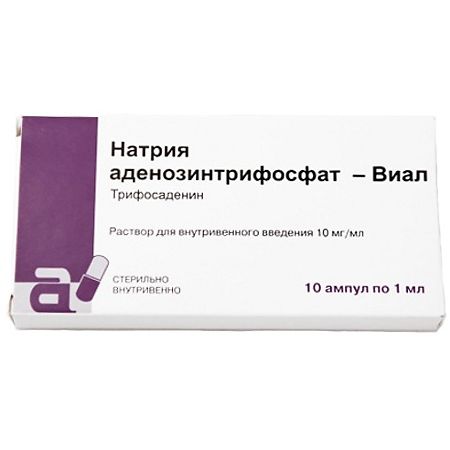No products in the cart.
ATP, 1%, 1 ml, 10 pcs.
€1.00
Out of stock
(E-mail when Stock is available)
Description
Sodium adenosine triphosphate (ATP) is a metabolic agent, has an antiarrhythmic effect, also has a hypotensive effect, dilates coronary and cerebral arteries. It is a natural macroergic compound. It is formed in the body as a result of oxidative reactions and in the process of glycolytic breakdown of carbohydrates. It is found in many organs and tissues, but most of all in the skeletal muscles. It improves metabolism and energy supply of tissues.
Transfer of ATP causes decrease of arterial pressure and relaxation of smooth muscles, improves nerve impulse conduction in vegetative ganglia and transfer of excitation from vagus nerve to heart, increases myocardial contractility. After parenteral administration it penetrates the cells of organs where it splits into adenosine and inorganic phosphate with release of energy.
Indications
Indications
As part of complex therapy for muscular dystrophy and atrophy; to relieve paroxysms of supraventricular tachycardia; with spasms of peripheral vessels (intermittent claudication, Raynaud’s disease, thromboangiitis obliterans).
For central, peripheral and mixed forms of hereditary retinal pigmentary degeneration.
Pharmacological effect
Pharmacological effect
Sodium adenosine triphosphate (ATP) is a metabolic agent, has an antiarrhythmic effect, also has a hypotensive effect, dilates the coronary and cerebral arteries. It is a natural high-energy compound. It is formed in the body as a result of oxidative reactions and in the process of glycolytic breakdown of carbohydrates. Contained in many organs and tissues, but most of all in skeletal muscles. Improves metabolism and energy supply to tissues.
Due to its breakdown into ADP and inorganic phosphate, ATP releases a large amount of energy used for muscle contraction, protein synthesis, urea, metabolic intermediates, etc.
Under the influence of ATP, blood pressure decreases and smooth muscles relax, the conduction of nerve impulses in the autonomic ganglia and the transmission of excitation from the vagus nerve to the heart improves, and myocardial contractility increases. After parenteral administration, it penetrates into organ cells, where it is broken down into adenosine and inorganic phosphate, releasing energy.
Subsequently, the cleavage products are included in ATP resynthesis. The antiarrhythmic effect is due to adenosine formed during the breakdown of ATP, which suppresses the automaticity of the sinoatrial node and Purkinje fibers (blockade of calcium channels and increased permeability to potassium ions).
Special instructions
Special instructions
Intravenous administration of the drug, as a rule, must be carried out in a hospital setting, under medical supervision, with monitoring of heart function, slowly, after which it is advisable to measure blood pressure.
Active ingredient
Active ingredient
Trifosadenine
Composition
Composition
1 ml of solution for intravenous administration contains:
active ingredient:
adenosine triphosphoric acid 10 mg.
excipients:
sodium hydroxide solution 2 M (up to pH 7.0-7.3),
water for injections.
Contraindications
Contraindications
Individual hypersensitivity to the drug,
acute myocardial infarction,
arterial hypotension,
severe forms of bradyarrhythmias,
AV blockade II-III degree,
decompensated stage of heart failure,
cardiogenic shock and other types of shocks,
QT prolongation syndrome,
hemorrhagic stroke;
inflammatory lung diseases,
chronic obstructive pulmonary diseases (for example, bronchial asthma);
pregnancy,
breastfeeding period,
childhood.
Side Effects
Side Effects
From the central nervous system: headache, dizziness, short-term loss of consciousness, a feeling of constriction in the head, phobias.
On the part of the organ of vision: blurred vision.
From the gastrointestinal tract: nausea, metallic taste in the mouth, increased motility of the gastrointestinal tract (with intravenous administration).
From the cardiovascular system: palpitations, discomfort in the chest, tachycardia or bradycardia, arterial hypotension, arrhythmia, impaired AV conduction (atrioventricular block), asystole.
From the musculoskeletal system: pain in the arms, back, neck.
From the urinary system: increased diuresis.
From the respiratory system: shortness of breath, bronchospasm.
Changes in the skin and subcutaneous tissue: facial flushing, itching, skin rash.
Disturbances at the injection site: tingling sensation.
Allergic reactions: hypersensitivity reactions, allergic dermatitis, urticaria, anaphylactic shock.
General disorders: increased sweating, hyperthermia, feeling hot.
Interaction
Interaction
When used together with dipyridamole, the effect of dipyridamole is enhanced, in particular its vasodilating effect.
Some antagonism appears when the drug is used together with purine derivatives (caffeine and theophylline).
It should not be administered simultaneously with cardiac glycosides in large doses, as the risk of adverse reactions from the cardiovascular system increases.
When used simultaneously with xanthinol nicotinate, the effect of sodium adenosine triphosphate is reduced.
Carbamazepine can enhance the effects of adenosine and lead to the development of blockade.
Overdose
Overdose
Symptoms: dizziness, arterial hypotension, short-term loss of consciousness, arrhythmia, atrioventricular block of the second and third degrees, asystole, bronchospasm, ventricular disorders, sinus bradycardia and tachycardia. It is also possible to develop allergic reactions.
Treatment. Administration of the drug is stopped immediately and cardiotonic drugs are prescribed. Therapy is symptomatic. Competitive antagonists of adenosine are xanthines (aminophylline, theophylline).
Storage conditions
Storage conditions
In a place protected from light, at a temperature of (5±2)°C.
Shelf life
Shelf life
2 years.
Manufacturer
Manufacturer
Vial, Russia
Additional information
| Shelf life | 2 years. |
|---|---|
| Conditions of storage | In the dark place at (5±2)°С. |
| Manufacturer | Vial, Russia |
| Medication form | solution for infusion |
| Brand | Vial |
Related products
Buy ATP, 1%, 1 ml, 10 pcs. with delivery to USA, UK, Europe and over 120 other countries.












